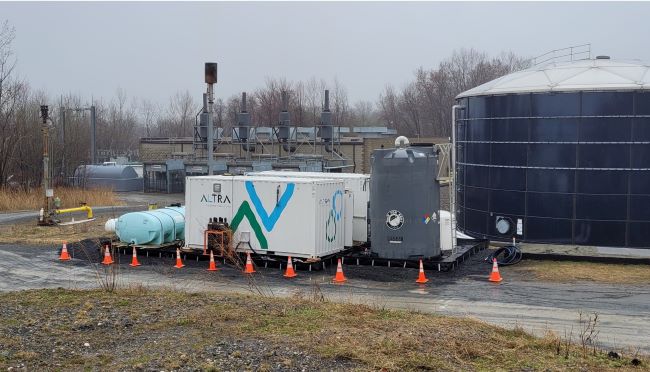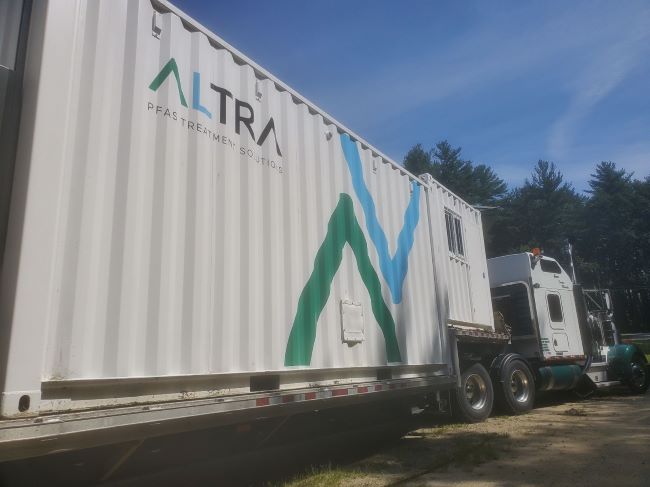Few emerging issues are as contentious for the waste industry as contamination by per-/poly-fluoroalkyl substances (PFAS). These substances, now better known as forever chemicals, are found in everything from single-use items, food packaging, carpets, rain-retardant and oil-resistant clothing, stain-resistant upholstery, personal care products including dental floss, copy paper, kitchenware, and wastewater treatment plant (WWTP) biosolids–all of which end up in landfills and contribute to the presence of PFAS in landfill leachate. Leachate is produced at landfills from the percolation of precipitation through solid waste as well as from liquid waste migrating downgradient. Due to their widespread nature, the chemicals–which have been linked to cancer and numerous other health problems–exist in the blood of most humans and are likely in most, if not all, landfills. In the U.S. and Canada, most landfills discharge their leachate to municipal or private WWTPs, where the PFAS in the leachate either passes straight through the plant and ends up being discharged in the WWTP effluent to surface waters, or partitions to the biosolids and ends up being land applied, used as fertilizers, or returned as waste to landfills, continuing the PFAS cycle.
In the U.S., the EPA and individual states are proposing, or implementing, regulations for PFAS in drinking water, groundwater, surface water, and biosolids, all of which may impact daily landfill operations, potentially requiring landfills to pre-treat their leachate to remove/reduce PFAS prior to discharging the treated leachate to a WWTP, as well as potentially restricting the acceptance of PFAS-contaminated WWTP biosolids by landfills. PFAS regulations in Canada are not quite as severe, but public concern is growing and pressure to act is being felt by governments.
Modern landfills, through design, are a safe and secure place for materials containing PFAS. Since PFAS eventually leave the landfills via leachates, emphasizing the need for pre-treatment methods is key. According to presenters and attendees at the 2022 Global Waste Management Symposium (GWMS) held February 14 to 17 in Indian Wells, California, landfills need new and updated methods for managing, treating, and destroying PFAS as soon as possible. During his keynote speech, Waste Connections’ James Little stated that landfill operators must work through uncertainties surrounding the possible environmental impacts of PFAS. Though debates over how to manage PFAS have been ramping up for years, Little stressed that operators need to take action now, even as major questions about how to manage, treat, or destroy the substances remain. “That time is already here,” he said, “I’m worried we’re behind the curve.” Little expressed a sense of urgency regarding the need to scaleup solutions for handling PFAS, calling for help from researchers, technology companies, and others in the audience who could determine “how effective landfilling is, and how significant migration pathways like stormwater, landfill gas, and leachates can be for PFAS to get out of the landfills we have,” he said.
Little expects public and private wastewater treatment works to become “less and less available” once the U.S. EPA sets drinking and surface water standards. This has prompted Waste Connections to develop its own on-site treatment and disposal options for leachate, he said. He noted that some projects are “placeholders” for anticipated new technologies that can better manage PFAS. “We need more cost-effective and scalable treatment technology, and we need it fast,” said Little. The EPA’s interim guidance for PFAS disposal or destruction has not offered definitive rules for the best methods or approaches.
When an audience member asked if waste companies are ready to implement such solutions, or if they will “sit back and wait” for federal or state regulations to prompt changes, Little responded that Waste Connections and other operators have expressed a hunger for reliable PFAS management techniques.
We need that solution now. Whatever works best, I’m agnostic, but we need scalable technology very, very soon.”
In this context, some landfill operators have decided to address the situation directly. Whether they like it or not, PFAS are present in landfills in significant quantities because products containing PFAS end up in landfills. Semantically, some could argue that landfills are not a source of PFAS, rather a product end-of-life receptacle. But for downstream WWTPs, landfill leachates are a major source of incoming PFAS.
Interestingly, demonstration projects previewed at the recent WEFTEC 2022 conference in New Orleans have shown that the type of PFAS can vary significantly from site to site, and even cell to cell, reaching concentrations up to 10,000 ng/L and even 100,000 ng/L, which are very high, for the sum of 25 to 33 specific PFAS compounds depending on the US EPA analytical method employed. Quite far from the guidance levels of 10 ng/L or less recommended for PFAS-contaminated groundwater.
Other reported findings are quite surprising as well. The type of PFAS found in the leachates from products disposed of in landfills differs significantly from the type of PFAS, mainly longer-chain PFAS, used in these products for decades. Indeed, leachate analyses show an important, even sometimes predominant, proportion of shorter-chain PFAS like PFBS, PFBA and PFHxA, contrary to the expected longer-chain PFAS, like PFOA and PFOS, contained in these landfilled products. The potential transformation (not to be confused with degradation) of PFAS in these large bioreactors, that are landfills, into a myriad of smaller molecules, for which ecotoxicological scientists have yet to conclude on a complete ecotoxicological picture.
As such, landfill and downstream wastewater treatment operators must be mindful of PFAS targeted with drinking water health advisory values (e.g., PFOA, PFOS, GenX, PFBS) in their treatment, but also of all other short(-er) chain PFAS that are predominantly found in the leachates with which they must contend.
Besides PFAS, these leachates also carry other significant contaminants: dissolved solids (metals, salts, etc.), ammonia and nitrogen compounds, particulate matter, organics (chemical and biological oxygen demand), and pesticides. Most landfills discharge untreated leachate directly to wastewater treatment plants, however some landfills have leachate pre-treatment systems, typically either a biological treatment system (single or sequenced reactors with membraned or biofilm carriers) which is used to reduce ammonia/nitrogen compounds as well as organics (BOD and COD), or a membrane filtration system (reverse osmosis or ultrafiltration) which also reduces nitrogen compounds, dissolved solids, suspended solids and chlorides. When considering how to deal with PFAS in their leachates, landfill operators need to either install a stand-alone PFAS treatment system or integrate a PFAS treatment system with their existing biological or
membrane treatment systems (exactly where depends on the specifics of the existing treatment system and PFAS treatment targets). The integrated PFAS treatment system would deal with the leachate itself and/or the RO reject, if applicable. Since leachates are often collected from various cells within a landfill and directed to the WWTP, a recommended practice would also include adding a leachate equalization tank to blend the various leachates and to deal with seasonal or episodic variations in flowrates and varying PFAS types and concentrations. Having a PFAS treatment system that can adapt to all these combinations is of great value.
Which is exactly what so-called foam fractionation does, a process commonly used in aquariums for the removal of organic waste. In essence, foam fractionation is a physico-chemical separation of hydrophobic molecules from a liquid (aqueous) solution using rising columns of air/gas bubbles or foam, a process that has enjoyed broad applications by the chemical industry. In the last few years, several variations of this process have been presented for dealing with PFAS in landfill leachates, some relying on a batch or semi-batch process, some on a continuous one. Recent real-scale field demonstrations of successful and cost-effective PFAS removal from landfill leachates using foam fractionation have been publicized by a few technology providers.

At WEFTEC 2022, we had the opportunity to present ALTRA PFAS Treatment results for two projects where 1,600 m³ of landfill leachates were treated. Results were more than promising. These projects showed that it was possible to remove very significant portions (up to 99.5 per cent) of the long-chain PFAS (PFHpA, PFHxS, 6:2 FTSA, PFOA, PFOS, PFNA, 8:2 FTSA, PFDA), using a continuous foam fractionation process at flowrates between 60 and 160 L per minute. More importantly, results showed that the sum of all PFAS detected (including short-chain) in the leachates could be removed by 70 per cent and greater, indicating that a large proportion of short-chain PFAS (PFMPA, PFPeA, PFBS, 4:2 FTSA, PFHxA, PFPeS, PFBA) could be removed by foam fractionation alone (up to 60 per cent removal of the short-chain PFAS detected). This could be achieved by using appropriate additives, or no additives, depending on the specific chemical composition of the leachates. In some cases, best results were obtained without any additives, while in others a low dosage of surfactant (e.g., soap), cationic or anionic depending on the leachate treated, helped optimize the PFAS removal process. Finally, results indicated that the volume of PFAS concentrate solution generated by this foam fractionation process could be as low as approximately 1 per cent of the incoming leachate, and even lower to 0.1 per cent if a downstream concentrator was used.
If treated leachate PFAS targets imposed by state and federal authorities in the USA warrant it, polishing of foam fractionation treated leachate using downstream media capture (granular activated carbon or ion exchange resins, and others) can be added to achieve even lower PFAS concentrations in the treated leachate. In Canada, current recommended PFAS targets remain sufficiently high and can be met using foam fractionation only without requiring downstream media capture.
These results indicate that it is possible to remove PFAS in the leachates using the foam fractionation processes prior to releasing them into downstream WWTP. Depending on the individual PFAS concentrations and PFAS types in the incoming leachates, foam fractionation alone could be enough to deal with PFAS in the landfill leachates.
A question yet remains: what do we do with the PFAS concentrate generated by foam fractionation? Since landfills are known to sequester and transform PFAS, a possibility would be to send the PFAS concentrates directly back into the landfill. Recycling PFAS concentrates back to the landfill may result in increased PFAS concentrations in the raw leachate. However, landfill operators have shared that they believe that the increase would be negligible due to inherent dilution occurring in landfills. Some could argue that the initial liability associated with the PFAS concentrates remains and even increases if recirculated back to the landfill in a never-ending cycle, but from an economic standpoint, this would appear the most cost-effective solution.
Another solution is to sequester the PFAS concentrates permanently. To this end, recent advances have been reported in the domain of PFAS encapsulation and stabilization in concrete casts. Again at WEFTEC 2022, we shared our results from concrete casts made using proprietary ingredients mixed with PFAS concentrates from a landfill leachate treated by foam fractionation. As part of the testing protocols to demonstrate the effectiveness of this method, the concrete cast was subjected to an EPA approved test method, aiming at simulating 100 years of exposure in a landfill. The cast were exposed to a synthetic leaching procedure with the resulting liquids analyzed for PFAS. The results demonstrated that using this method most of the PFAS were successfully encapsulated and stabilized within the casts. This method appears promising as a very effective, long-term way to manage the PFAS concentrates generated by foam fractionation.
Some jurisdictions will require PFAS concentrates to be destroyed. Various thermo-oxidation (for the experts, thermal desorption, sub-critical or supercritical wet air oxidation) and electro-oxidation processes are currently being developed but most are not yet commercial. However, some of these are proving to be quite appealing. PFAS destruction results from electro-oxidation (boron doped diamond electrodes) previewed at WEFTEC 2022 showed extremely effective destruction of PFAS concentrates from landfill leachates. Other technologies are also reported to be effective, based on plasma for instance. The challenge with these technologies will be cost-effectiveness and environmental permitting for on-site destruction.

Irrespective of whether they are sequestered, stabilized, or destroyed, PFAS in landfill leachates as well as in other types of PFAS-contaminated streams (groundwater from firefighting training areas, industrial rejects, etc.) will still need to be concentrated by a factor of 1,000, if not more, for these PFAS end-of-life avenues to become affordable, practicably speaking.
While PFAS remediation remains a real challenge on many accounts, point-source treatment is part of the solution. For landfill operators, cost-effective solutions are being demonstrated in the field today, which brings some reasonable confidence that ultimately the PFAS challenge will be overcome.
Steven Butel and Martin Bureau are with ALTRA PFAS Solutions









